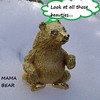Posted 2 years ago
 Loetzforever
Loetzforever
(100 items)
I would like to introduce you to two vases from the Art Deco company Loetz. The decoration of the two vases was created by fine etching and additional grinding. The large vase with the production number II 8441/10, produced in many other variants (about 44), was made after 1914 according to the notes on the pattern (Lötz, Series II, Lnenickova), probably around 1927/28. See also the sample sheet from the Lötz company in the book Lötz I (Ricke) on page 589, figure 24. This vase form is shown there with a chandelier and another cut flower decoration. The small vase with the production number III 512 also dates from this period (same illustration). The technical design of the vases is state-of-the-art, see the design by Otto Prutscher from 1929 with a geometric pattern, PN III 4846 (Lötz II, Ricke).
See also the article on the Loetz.com website "A Study of Loetz Cut Glass Production" from position 12.01.
Since these decors deviate from the previously known printed sample sheets from the Lötz company (see above), I think it still has to be finally clarified whether these decors were really made by the Lötz company or whether the Lötz semi-finished products were finished by other companies.
From around 1924 the hollow glass industry in Europe found itself in a general crisis, which also hit the Lötz company harder, so that it was forced to look for competing smelters (Johann Oertel & Co. Haida Com. 1514, Schmid Annathal, Kralik, Meyer's nephew, Tiroler Glashütte in Rattenberg and Riedel in Polaun ( Ricke)) to produce semi-finished products. It is possible that these vases were delivered to other companies and then refined (polished and etched) by them. However, it must be noted that the Lötz company produced a great deal of previously unknown glass with decorative cuts in its late phase. There are some surviving pattern cuts where a cut is noted, such as PN II 8653 with cut no. 59, lamp PN 8779 mentions a cut and an additional etched decoration.
Draft circa 1927, PN II 8441/10, nailed with dark blue,
nailed glass overlaid blue, blown into shape and
raised, then etched in an acid bath (with a tulip pattern), then additionally refined with a notch cut. The bottom and the rim have been ground flat.
H. 26.2 cm.
Draft circa 1927, PN III 512, topaz overlaid with dark blue, topaz colored glass blue, blown into the mold and
raised, then etched in an acid bath (with a pattern of leaves and geometric shapes), then additionally refined with a notched cut. The bottom and the rim have been ground flat. H. 16 cm
Loetz: Zwei Vasen, Art Deko um 1927/28, geätzt und geschliffen.
Ich möchte Ihnen zwei Vasen der Firma Lötz aus dem Art Deko vorstellen. Das Dekor der beiden Vasen wurde durch eine feine Ätzung und einem zusätzlichen Schliff erzeugt. Die große in vielen anderen Varianten (zirka 44) erzeugte Vase mit der Produktionsnummer II 8441/10 wurde nach den Notizen auf den Schnittmustern (Lötz, Serie II, Lnenickova) nach 1914 hergestellt, vermutlich um 1927/28. Siehe hierzu auch das Musterblatt der Firma Lötz im Buch Lötz I (Ricke) auf Seite 589, Abbildung 24. Dort ist diese Vasenform mit einem Lüster und einem anderen geschliffenen Blumendekor abgebildet. Die kleine Vase mit der Produktionsnummer III 512 stammt ebenfalls aus dieser Periode (gleiche Abbildung). Die Vasen sind mit ihrer technischen Ausführung auf der Höhe der Zeit, siehe hierzu den Entwurf von Otto Prutscher von 1929 mit einem geometrischen Muster, PN III 4846 (Lötz II, Ricke).
Siehe auch den Artikel auf der Website Lötz.com "A Study of Lötz Cut Glass Production" ab Position 12.01.
Da diese Dekore von den bisher bekannten gedruckten Musterblättern der Firma Lötz abweichen (siehe oben), muss meines Erachtens noch endgültig geklärt werden, ob diese Dekore wirklich von der Firma Lötz ausgeführt, oder die Lötz-Halbfabrikate von anderen Firmen veredelt wurden.
Ab zirka 1924 befand sich die Hohlglas-Industrie in Europa in einer allgemeinen Krise, die auch die Firma Lötz verstärkt traf, so daß diese gezwungen war, für Konkurrenzhütten (Johann Oertel & Co. Haida Com.1514, Schmid Annathal, Kralik, Meyers Neffe, Tiroler Glashütte in Rattenberg und Riedel in Polaun (Ricke)) Halbfabrikate herzustellen. So kann es sein, daß diese Vasen an andere Unternehmen geliefert und anschließend von diesen veredelt (geschliffen und geätzt) wurden. Allerdings muß vermerkt werden, daß die Firma Lötz in ihrer Spätphase sehr viel bisher unbekanntes Glas mit Zierschliff hergestellt hat. Es gibt einige erhaltene Musterschnitte, bei denen ein Schliff vermerkt wurde, wie zum Beispiel PN II 8653 mit dem Schliff Nr. 59, bei der Lampe PN 8779 wird ein Schliff und ein zusätzlich geätztes Dekor erwähnt.
Entwurf zirka 1927, PN II 8441/10, annagelb mit dunkelblau,
annagelbes Glas blau übefangen, in die Form geblasen und
aufgetrieben, anschließend im Säurebad geätzt (mit einem Tulpenmuster), anschließend zusätzlich mit einem Kerbschliff veredelt. Der Boden und der Rand wurden plangeschliffen.
H. 26,2 cm.
Entwurf zirka 1927, PN III 512, topas mit dunkelblau, topasfarbenes Glas blau übefangen, in die Form geblasen und
aufgetrieben, anschließend im Säurebad geätzt (mit einem Muster aus Blättern und geometrischen Formen), anschließend zusätzlich mit einem Kerbschliff veredelt. Der Boden und der Rand wurden plangeschliffen. H. 16 cm


































WOWZA !!!!
AMAZING!!
scott
very nice the two vases, so balanced, son architectural ..... and thanks for all the information
Thank you to all, Merci beaucoup à tous, Dankeschön an alle!